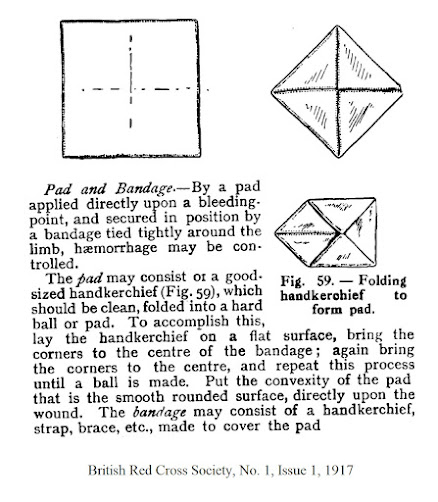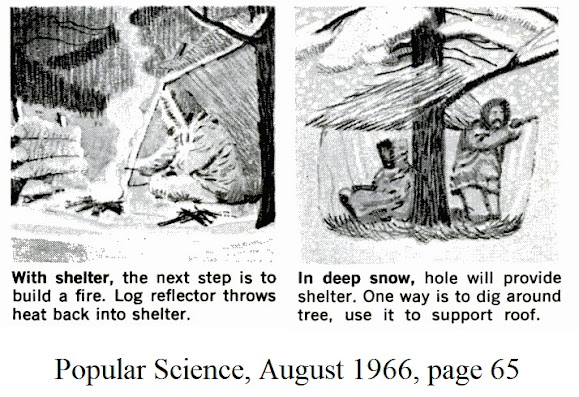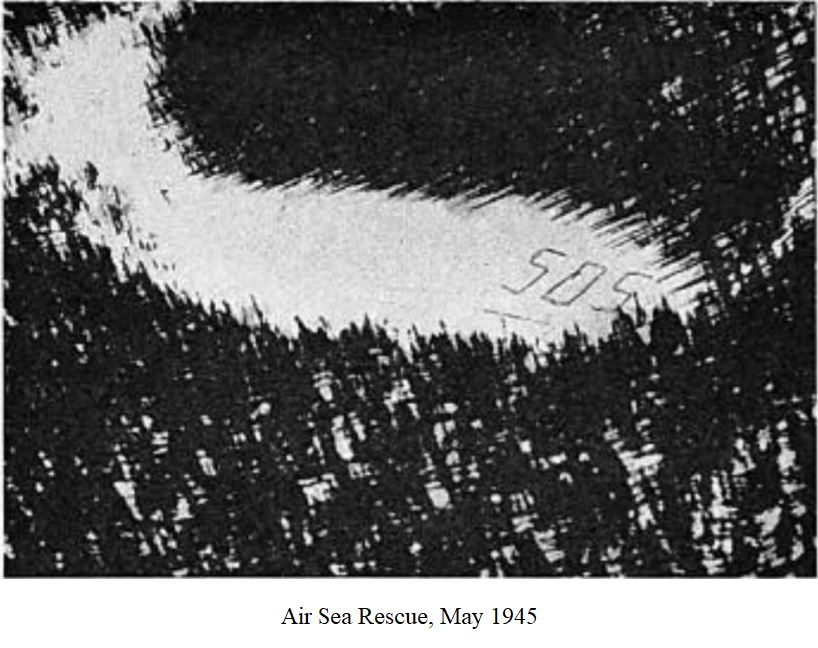Recently,
I found a copy of United States Navy, Sea & Land Survival, Device 9B7,
I was intrigued by how it broke down a survivor’s
priorities into separate lists for land and water survival. Also, I noticed that were different, but
similar, to the survival priorities described by the “Rule of Threes”. It got me thinking and so, here are some
thoughts, on why survival priorities are listed just “...in that order...”.
Water survival
equals floating...
Flotation,
this is where land and water survival priorities differ, because if you suddenly
dropped into a water survival situation the first thing you need to do is to
keep your head above water!
If
you are traveling over water, by boat or plane, you should always wear a
Personal Flotation Device (PFD); the Transportation Safety Board of Canada
conducted a study of 103 fatal plane crashes between 1975 and 1990 and found
that approximately three out of every four people, who died as the result small
plane crashes into water, died from drowning1, and 10% were
unconscious due to non-fatal injuries when they drowned. So, don’t sit on or stow that PFD, wear that it!
Being wet or in cold water can kill you, as it quickly causes hypothermia, a condition where your body can not produce or conserve enough heat to survive. And as you get colder the dexterity of your hands drops off quickly, and the colder you get, the faster this happens. When your hand’s skin temperature drops to 55 to 65o F (13 to 18o C), dexterity begins to drop off. At a hand skin temperature of 50o F (10o C), you will experience numbness and diminished feeling, your ability to tie and untie knots will fall by 25% and your grip strength decreases by as much as 50%. In cases of total body immersion in water that is 32o F (0o C), you can lose hand dexterity in less than a minute!
If
you are in the water and you can get out, either by getting to land, or by
boarding a raft or a boat, do it as soon as possible, before your hand
dexterity declines. For the same reason,
once you are in the raft, or out of the water, you need to carry out all
necessary survival activities before your hands get too cold.
For
more on this, read ‘Being Wet Kills, Fast!©”, HERE.
The ABCs of
first aid
As
soon as you can after the crash, or after you are safe from drowning, you
should provide first aid to the injured.
Start with the ABCs of first aid and first check to make sure an unconscious, injured person’s airway is open and that they are breathing, by looking, listening, and feeling, for signs of respiration. If they aren’t breathing, then begin artificial respiration and continue until they begin to breath on their own, a trained person relieves you, or you are exhausted and cannot continue. After the first two breathes, check for a pulse and if there
is no pulse begin cardiopulmonary respiration (CPR). Again, once you have started CPR, continue to
provide it until either their heart begins to beat on its own, a trained person
relieves you, or you are exhausted and cannot continue.
If
the injured person is bleeding, especially if the blood is bright red and
spurting, you have only moments to stop the bleeding before death occurs. Severe bleeding can quickly become
life-threatening, and the average time to bleed out is only two to five minutes.
Also,
in a survival situation, infections can quickly become life threating, so clean
and cover cuts and injuries, if possible.
Look
for the signs of shock among the injured, also, and keep them warm, covered and
reassured.
Shelter
According
to the “Rule of Threes”, and the land and water survival priorities, shelter
is the next most important thing you need to do after treating any injuries and
providing first aid. As soon as possible,
protect yourself from the wind and the elements, because if your clothes are
wet, and it is windy, you will lose body heat 240 times faster than if your clothes
are dry.
Once
your shelter or wind-break is built, build a fire. In survival situations fires are vital for
warmth, and disinfecting water. Fire is
the only comfort of civilization that can easily be taken with you into the wilderness
IF you are prepared and have learned how to build one. Fire provides warmth, discourages wild
animals, allows for thawing and disinfecting water, and provides a large
measure of mental comfort and support.
For
more on building a fire, read “Could You Survive, Survival Priorities©”, HERE,
“The Top Ten Wilderness Survival Skills...Number Six©”, HERE,
“The Top Ten Wilderness Survival Skills...Number Seven©”, HERE,
“Remember This If You Want to be Warm ©”, HERE,
“Your Campfire and How to Use It ©”, HERE,
and “Winter Survival for Tommy...Part Five©”, HERE.
“E.T. phone
home...”
The next most important
thing after you have found or built shelter from the wind and the elements, is
to create some signals to help the rescuers find you.
Remember, it is not
always easy to see you or the wreck, so you need to make it easier to be
spotted, and that is where signals come in.
There are many ways of
attracting attention, but some things attract attention better than others, so
try blowing a whistle, flashing with a mirror, making an SOS symbol, lighting three
fires in a row or a triangle, making smoke signals, etc. Be ready to signal as soon as you see or hear
signs that rescuers are approaching.
The
simplest distress signal is an “SOS” signal, tramped out in the snow. The letters should be made by stomping out
wide paths to form letters at least ten feet (3 meters) square and ten feet (3
meters) apart. It would be better to
make the letters using a 6 to 1, vertical to horizontal ratio, where the
vertical lines are 60 feet tall (18 meters), and the horizontal lines are ten
feet wide (3 meters). If possible,
rocks, wreckage, or pine boughs should be laid in the tracks to emphasize the letters.
Water
In a survival situation, living is spelled W A T E R! You can only survive for about three days without water to drink. But remember,it is the water inside you that counts, don’t be that guy who is so compelled to ration his water that he dies of dehydration with water still in his canteen. Don’t ration water, ration sweat and preserve body water , by moving or working at night when it is cooler, staying out of the sun, avoiding eating if you are low on water, etc.
For more read “Melting Snow and Ice ©”, HERE, “Fire Burn and Cauldron Bubble...The 5 Stages of Boiling©”, HERE, “...No soldiershould Drink any water without it Being Boiled...©”, HERE, “Water Disinfection: When is boiled, boiled enough…? ©”, HERE, and “They Can’t Cure Dead ©”, HERE.
Food
You can live weeks without eating, so don’t stress out about not having anything to eat. Food is usually the last thing that you will need in a survival situation, and you can live weeks without eating, so don’t stress out about not having enough or anything to eat.
Metabolic
water is the water produced when food is digested. If available, eat sugary foods like sucking
candies or packets of sugar. The
digestion of carbohydrates produces a net gain of metabolic
water as they are digested by your body and will provide energy to run your
heat furnace. Proteins, on the other
hand produce the least metabolic water, and in fact require the metabolic water
that is produced, to excrete the urea and other waste products of protein
digestion.
Don’t forget to come back next week and read “A 'Compact' Survival
Kit©”, where we will talk about making a minimum, basic survival kit.
I
hope that you continue to enjoy The Woodsman’s Journal Online and look for me
on YouTube at BandanaMan Productions for other related videos, HERE. Don’t forget to follow me on both The
Woodsman’s Journal Online, HERE,
and subscribe to BandanaMan Productions on YouTube. If you have questions, as always, feel free
to leave a comment on either site. I
announce new articles on Facebook at Eric Reynolds, on Instagram at
bandanamanaproductions, and on VK at Eric Reynolds, so watch for me.
That
is all for now, and as always, until next time, Happy Trails!
Notes
1
The study found, that 10% (or 17 persons) were incapacitated or
unconscious from non-fatal impact
injuries and drowned and that an additional 67% (or 42 persons) died from
drowning.
From
“Seaplane Water Survival”, by H. Dean Chamberlain,
Sources
Burkhardt, Robert; “A
Matter of Iron Rations”, The Skipper, June 1960, [The Skipper Publishing
Company, Washington, D.C.] page 26, 49 – 51, https://books.google.com/books?id=_agPAAAAIAAJ&pg=RA7-PA51&dq=pocket+survival+kit&hl=en&newbks=1&newbks_redir=0&sa=X&ved=2ahUKEwjElLbTu778AhUJMlkFHdkbCSk4RhDoAXoECAkQAg#v=onepage&q=pocket%20survival%20kit&f=false,
accessed February 8, 2023
Calvert,
John H., Jr. Colonel; “Frostbite”, Flying Safety, October 1992, Publication 127-2, Vol. 48, No. 10,
[United States Airforce, 1992], pages 14 - 15, https://books.google.com/books?id=W2PU4Rad3JMC&pg=RA21-PA26&dq=survival+pamphlet&hl=en&newbks=1&newbks_redir=0&sa=X&ved=2ahUKEwim-sLv-cT8AhWMKFkFHf9FA184PBDoAXoECAkQAg#v=onepage&q=survival%20pamphlet&f=false, accessed January 13, 2023
Chamberlain,
H. Dean; “Seaplane Water Survival”, FAA Aviation News: A
DOT/FAA Flight Standards Safety Publication, Volumes 33-34, July-August 1995,
pages 10 to 12, https://books.google.com/books?id=IP05AQAAMAAJ&pg=RA12-PA12&dq=faa+aviation+news+july-august+1995+%22of+the+168+occupants%22&hl=en&newbks=1&newbks_redir=0&sa=X&ved=2ahUKEwj-hpmznMuAAxWEFlkFHRT5B5EQ6AF6BAgHEAI#v=onepage&q=faa%20aviation%20news%20july-august%201995%20%22of%20the%20168%20occupants%22&f=false,
accessed August 7, 2023
Combat Crew Training
Wing; “Obtaining Water”, Flying Safety, October 1992, Publication 127-2,
Vol. 48, No. 10, [United States Airforce, 1992], pages 26, https://books.google.com/books?id=W2PU4Rad3JMC&pg=RA21-PA26&dq=survival+pamphlet&hl=en&newbks=1&newbks_redir=0&sa=X&ved=2ahUKEwim-sLv-cT8AhWMKFkFHf9FA184PBDoAXoECAkQAg#v=onepage&q=survival%20pamphlet&f=false,
accessed January 13, 2023
Mullen, John, SSGT;
“Surviving the Winter Emergency”, Flying Safety, United States Air
Force, November 1985, Volume 41, Number 11, page 2-7, https://books.google.com/books?id=h9qH2OtBlcoC&pg=RA8-PA5&dq=winter+survival+car+improvised&hl=en&newbks=1&newbks_redir=0&sa=X&ved=2ahUKEwisus3HiuP8AhXjEFkFHSwLDwkQ6AF6BAgGEAI#v=onepage&q=winter%20survival%20car%20improvised&f=false,
accessed January 27, 2023
Rathbone, Thomas M., Lt.;
“Bligh’ Me-Survival at Sea”, Surface Warfare, Volume 5, Issue 11,
November 1980, page 16 to 17, https://books.google.com/books?id=XNQDYsVnxQIC&pg=PA17&dq=body+fat+survival+sea&hl=en&newbks=1&newbks_redir=0&sa=X&ved=2ahUKEwiwgovgmb6AAxVMGFkFHZwTDak4ChDoAXoECAYQAg#v=onepage&q=body%20fat%20survival%20sea&f=false,
accessed August 7, 2023
United States Navy, Sea & Land Survival, Device
9B7, [Naval Training Equipment Center, Olando, FL], https://books.google.com/books?id=R3er5Ef-m28C&pg=PP1&dq=land+survival+9b7&hl=en&newbks=1&newbks_redir=0&sa=X&ved=2ahUKEwjHob3u4dD_AhXbKFkFHaHHAZUQ6AF6BAgDEAI#v=onepage&q=land%20survival%209b7&f=false,
accessed Aug 1, 2023
Department Of The Air Force, Survival
Training Edition, AF Manual 64-3, [Air Training Command, U.S. Government
Printing Office, Washington, D.C., August 15, 1969], page 2-7 to 2-10,
https://books.google.com/books?id=UaapWEpqo4cC&pg=PP3&lpg=PP3&dq=%22survival+training+edition%22+Af-64-3&source=bl&ots=EQPVWHeJ8j&sig=ACfU3U2tRMF4EHMi96DVdMj-9tV_MA3xWQ&hl=en&sa=X&ved=2ahUKEwimvOjN6vvnAhXEla0KHZPTAO44ChDoATABegQICRAB#v=onepage&q=%22survival%20training%20edition%22%20Af-64-3&f=false,
accessed April 16, 2018
Wright, H. T., CWO;
“Rigger’s Loft”, On Scene, May 197, page 17 to 18, https://books.google.com/books?id=uO0oLB7mws0C&pg=RA2-PA18&dq=days+of+food+around+your+middle+survival+sea&hl=en&newbks=1&newbks_redir=0&sa=X&ved=2ahUKEwjQ67bdmL6AAxXZrYkEHeNWCzw4HhDoAXoECAUQAg#v=onepage&q=days%20of%20food%20around%20your%20middle%20survival%20sea&f=false,
accessed August 7, 2023


























No comments:
Post a Comment